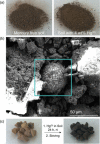The Mercury Problem in Artisanal and Small-Scale Gold Mining
- PMID: 29314284
- PMCID: PMC5969110
- DOI: 10.1002/chem.201704840
The Mercury Problem in Artisanal and Small-Scale Gold Mining
Abstract
Mercury-dependent artisanal and small-scale gold mining (ASGM) is the largest source of mercury pollution on Earth. In this practice, elemental mercury is used to extract gold from ore as an amalgam. The amalgam is typically isolated by hand and then heated-often with a torch or over a stove-to distill the mercury and isolate the gold. Mercury release from tailings and vaporized mercury exceed 1000 tonnes each year from ASGM. The health effects on the miners are dire, with inhaled mercury leading to neurological damage and other health issues. The communities near these mines are also affected due to mercury contamination of water and soil and subsequent accumulation in food staples, such as fish-a major source of dietary protein in many ASGM regions. The risks to children are also substantial, with mercury emissions from ASGM resulting in both physical and mental disabilities and compromised development. Between 10 and 19 million people use mercury to mine for gold in more than 70 countries, making mercury pollution from ASGM a global issue. With the Minamata Convention on Mercury entering force this year, there is political motivation to help overcome the problem of mercury in ASGM. In this effort, chemists can play a central role. Here, the problem of mercury in ASGM is reviewed with a discussion on how the chemistry community can contribute solutions. Introducing portable and low-cost mercury sensors, inexpensive and scalable remediation technologies, novel methods to prevent mercury uptake in fish and food crops, and efficient and easy-to-use mercury-free mining techniques are all ways in which the chemistry community can help. To meet these challenges, it is critical that new technologies or techniques are low-cost and adaptable to the remote and under-resourced areas in which ASGM is most common. The problem of mercury pollution in ASGM is inherently a chemistry problem. We therefore encourage the chemistry community to consider and address this issue that affects the health of millions of people.
Keywords: Minamata convention; artisanal and small-scale gold mining (ASGM); gold; mercury; mining.
© 2018 The Authors. Published by Wiley-VCH Verlag GmbH & Co. KGaA.
Figures




References
-
- None
-
- Reducing Mercury in Artisanal and Small-Scale Gold Mining (ASGM), United Nations Environment Programme. Accessed 10 October 2017 from http://web.unep.org/chemicalsandwaste/global-mercury-partnership/reducin...;
-
- Global Mercury Assessment 2013. Sources, Emissions, Releases and Environmental Transport, United Nations Environment Programme, Chemicals Branch, Geneva, Switzerland, 2013.
-
- de Lacerda L. D., Salomons W., Mercury from Gold and Silver Mining A Chemical Time Bomb?, 1998, Springer, Berlin.
-
- None
Publication types
LinkOut - more resources
Full Text Sources
Other Literature Sources

